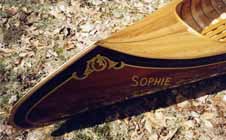Kevin Martin Wooden Boats & Canoes
Construction Techniques: Sailing Canoes

In the late 1800s, many builders in the east produced fine, decked canoes that were rigged for sailing. Meets were held and the small boats were extensively raced and used for cruising. The builders improved the designs yearly, vying for the honor of making the fastest or best cruising model.
I am now building a few of the best cruising designs and will custom build other models to suit your needs. These craft are built using lapstrake construction techniques, similar to the open canoes but decked over, leaving a comfortable cockpit to accommodate the traveler.
A watertight bulkhead is put in each end for floatation. These are constructed of hackmatack knees, cut to fit the laps of the planking, and screwed or nailed through the planks. A 3/8" pine bulkhead is riveted to these. Copper air tanks are used in some models or air bags could be tucked out of sight under the decks.
The deck beams of spruce are cut from patterns and screwed through the gunwales. Hardwood or hackmatack knees are used on the sides of the cockpit for strength. The deck itself is of ¼ thick appropriate wide hardwood or old growth pine heartwood, as this is a very stable and light wood. This can be made up of six sections scarphed across the beam, with a batten covering the center for expansion. This type of deck allows you to remove any section if repairs are necessary. The decks are fitted up against the coaming which surrounds the inside edge of the cockpit where you would sit. Hatches are added if desired to access the forward or rear sections of the decks for storage.
Mast steps of oak are fastened to the keel and mast tubes of copper are set in them. The tubes are sealed on the bottom to prevent water from entering from the decks and screwed through a flange at the deck. Floorboards are added and can be raised on ledgers, allowing room for ballast. The ledgers also add strength to the hull. The rudder and centerboard are of oak. The rudder lines run into the cockpit and can be controlled by hand or with foot pedals. The centerboard can be a folding bronze radix model that allows more room in the canoe, or the dagger board type with a normal centerboard trunk.
The type of sail can vary, but a lug rig is good for these canoes, with a size of 35 to 50 square feet for the mainsail and 12 to 25 square feet for the mizzen being good sizes for cruising. Masts and spars are spruce except mast diameter over 2 may be of pine. Sailing hardware such as cleats, pulleys and leads can be special made brass or bronze or many items can be made of wood at the shop. Sheets and Halyards can be of traditional 3-strand rope or the more modern sort braided style. Much of the work in these canoes is in the rigging and other sailing gear such as the rudder and centerboard so the cost will vary with the owners needs and the size of the sail rig.
These canoes vary in style from the simpler Rob Roy model, which is smaller in size with small rigs and simple gear that also paddle easy, to the longer sailing machines with heavy boards and larger rigs that can be set up with special gear such as hiking seats and a folding centerboard. The next option up would be the Canoe Yawl that will take passengers better and provide more stable sailing in bigger waters.


